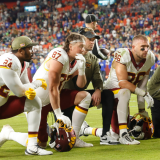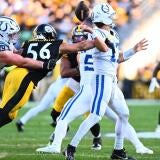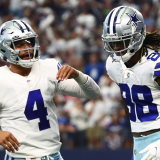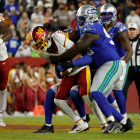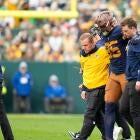
Fitting the 'Bill': Is Commanders rookie Jacory Croskey-Merritt the next late-round steal at running back?
How did one of the best RBs in the draft class last until pick No. 245?
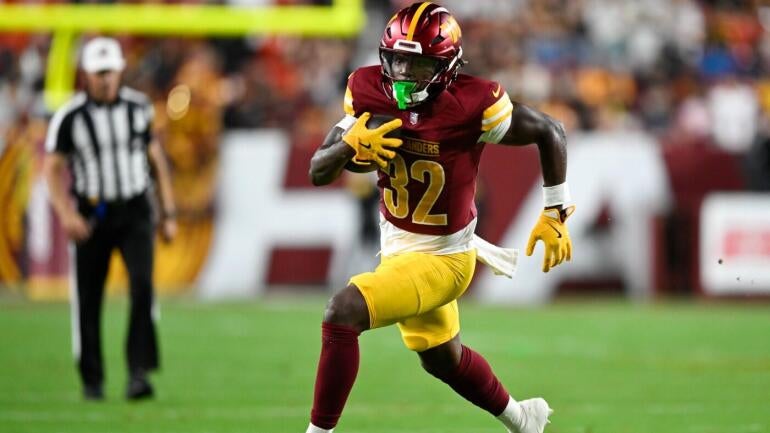
Isiah Pacheco was the 22nd running back taken in the 2022 NFL Draft, a seventh-round pick selected 251st overall by the Kansas City Chiefs. Heading into Week 1 of his rookie season, Pacheco was listed as RB3 behind Clyde Edwards-Helaire, a former first-round pick, and Jerick McKinnon, who was 30 years old and would play just one more NFL season.
Edwards-Helaire suffered an ankle injury in Week 11, the team placed him on injured reserve, and Pacheco took full advantage of the opportunity; over the last eight regular season games, he ran for 551 yards, two-thirds of his rookie total. He remained hot in the postseason, rushing for 197 yards over three games (5.1 yards per carry) that culminated in another Chiefs' Super Bowl.
Fast-forward to early May, when 25 running backs were selected in the 2025 NFL Draft. At the top, no surprise, was Ashton Jeanty, the sixth-overall pick. Twenty-four running backs and 239 selections later, the Commanders took Jacory Croskey-Merritt, who played one season at Arizona, and prior to that made stops at New Mexico and Alabama State.
If you watched Croskey-Merritt (who goes by Bill) in college, you probably weren't surprised to see him drafted. The problem was that there wasn't much tape to go on from 2024 -- he played just one game for the Wildcats because of eligibility issues -- and it came against his former team, New Mexico. But even in that limited sample size, it was pretty easy to see he was special.
When I first write up a prospect, I'll usually begin by looking up some biographical information on their college team's website, just to get a sense of who they are and what they've accomplished to date. On paper, Croskey-Merritt looked like a superstar.
At New Mexico, he once rushed for 200-plus yards in back-to-back games, becoming the first player in school history to accomplish the feat in a single season, let alone back-to-back games. So, yeah, that sounds impressive, but boxscore scouting won't get you very far. Turning on the tape from his last two college seasons told a story that loudly confirmed -- in bold, underlined and increased font size by several points -- the words at the beginning of this paragraph.
These were the first two sentences of my notes on Croskey-Merritt from last spring: "Insane short-area-quickness, with one of the best jump-cuts in draft class after Ashton Jeanty. He has open-field juice, elite contact balance and is a willing between-the-tackles runner."
We highlighted Croskey-Merritt at the Shrine Bowl back in January, and CBS Sports' Mike Renner was impressed with how good he looked during practices that week.
Again, that sounds effusive until you watched Croskey-Merritt in college, realized you struggled to find the words to convey the images burned into your brain and that you were, in fact, underselling it a good bit.
Hard not to see a little bit of Shady McCoy in new Arizona running back Jacory Croskey-Merritt. Incredible stop-start and feel for space.
— Ryan Roberts (@RiseNDraft) June 14, 2024
Transferred from New Mexico this offseason. pic.twitter.com/Pw72ab5wvb
We talk a lot throughout the draft process about skills translating from one level to the next, whether it's Division II to FCS, FCS to FBS or making the leap to the NFL. Because it's one thing to dominate at lower levels -- only to realize that was mostly a function of you being the best athlete on the field every week.
And maybe those were the concerns for Croskey-Merritt when he left Alabama State for New Mexico, but I'd imagine those concerns lasted less than the length of one practice. Same when he made his way to Tuscon, even if just for one game. And again, as the last running back taken in the 2025 class, where he quickly went from "that seventh-round rookie" to not only playing himself inside the 53-man roster, but allowing the Commanders to trade former third-round running back Brian Robinson Jr..
Every Preseason carry/catch by Jacory Croskey-Merritt (#32/Commanders). pic.twitter.com/dWN5ZAcRoe
— Franz Scout (@FranztheScout) August 26, 2025

So why did Croskey-Merritt last until pick No. 245? First, he's a 24-year-old rookie, and while that's not a deal-breaker, the two first-round running backs, Jeanty and Omarion Hampton, are 21 and 22. In fact, of the other 23 running backs drafted, only Woody Marks and RJ Harvey are older than Croskey Merritt.
Then there's playing for three schools over his final three college seasons, including the lone game he suited up for Arizona last fall before he was sidelined by eligibility issues. There just wasn't much tape of him playing against top-flight college competition. It's one thing to run for over 200 yards against Fresno State and Utah State, but it would have been instructive to see him against Big 12 opponents (Kansas State, Utah, BYU and Arizona State were all ranked inside the top 15 when the Wildcats faced them).
And, of course, there's the old refrain about running backs being replaceable, some version of "Why take one in the first round when you can find comparable productivity for a fraction of the price later in the draft!" (It's almost like a NFL Draft infomercial -- "Use the coupon code: FUNGIBLE for 20% off your next RB purchase and watch the savings roll in!")
Fair or not, there is some truth to this, and I don't even think it's controversial; offensive tackles, edge rushers and defensive linemen, cornerbacks and, of course, quarterbacks are more important to a team's success, much harder to find in the draft and regularly targeted earlier in the draft than running backs.
Look no further than the Commanders' last two draft classes: They took an offensive tackle and a cornerback in Rounds 1 and 2 in 2025, and the year before, it was quarterback, defensive linemen and nickelback.
This also feels like a good time to dispel the myth that "you can find running backs anywhere." Because you can't. You can find value later in the draft, for sure, but we can say that about any position. Since 2000, 151 running backs have rushed for at least 400 yards in their rookie seasons. Two of the top four rookie rushing leaders were sixth-rounders:
- Ezekiel Elliott: 1,631 yards (first-round pick)
- Alfred Collins: 1,613 yards (sixth-round pick)
- Clinton Portis: 1,508 yards (second-round pick)
- Mike Anderson: 1,487 yards (sixth-round pick)
But as you make your way through the top 50 rookie rushing leaders over the last quarter-century, you notice a trend: 25 first-rounders, 17 second-rounders and 11 Day 3 picks, including just one seventh-rounder in Pacheco.
In fact, only Pacheco, Bryce Brown and Daryl Richardson ran for more than 400 yards as rookie seventh-round picks. And in that sense, any early success Croskey-Merritt has in the NFL would be more anomalous than expected, though the names become more frequent and familiar as you work your way back through Day 3:
Rookie rushing yards by round
| Round 6 | Round 5 | Round 4 |
|---|---|---|
Alfred Morris (1,613) | Jordan Howard (1,313) | Bucky Irving (1,122) |
Mike Anderson (1,487) | Tyler Allgeier (1,035) | Chuba Hubbard (612) |
Elijah Mitchell (963 yds) | Tyrone Tracy Jr. (839) | Jamaal Williams (556) |
Aaron Jones (448) | Tony Pollard (455) |
There is some nuance to this discussion, however. Higher draft picks are more likely to make the team and be given more opportunities once they do. And in a different world, where Croskey-Merritt began his college career at Arizona, played three seasons there, stayed healthy and was the exact same player currently on the Commanders roster, he could have easily been a top-100 pick.
Put another way: He still is that player; it's just that his path to the NFL wasn't as direct as he had perhaps hoped. For what it's worth, he is a better prospect than Pacheco coming out of college; he's a more explosive runner, with better vision and big-play ability. And in that sense, Croskey-Merritt does feel like a steal as a late seventh-rounder, at least based on the brief glimpses we got in college and in the preseason.
The good news is that none of that matters now. He made the roster, and while he's currently RB4 behind Austin Ekeler, Chris Rodriguez Jr. and Jeremy McNichols, Croskey-Merritt is going to get his opportunity. Just like Pacheco had to bide his time as a rookie until an injury opened the door for him to subsequently kick down.


